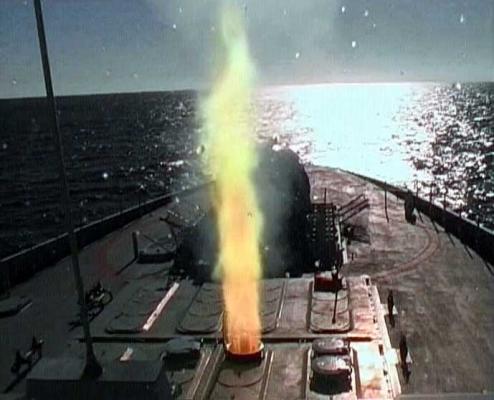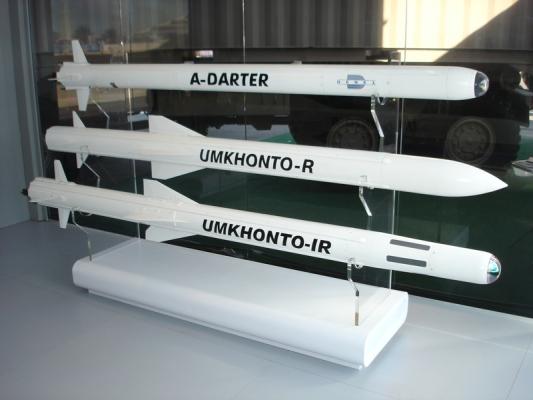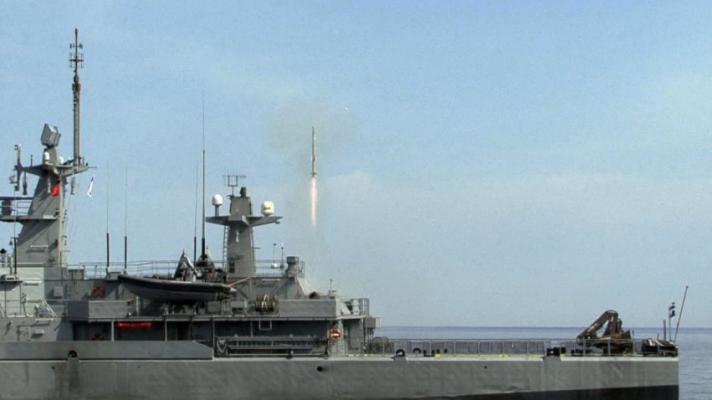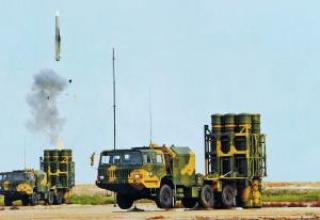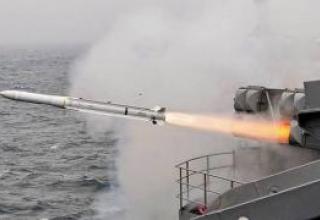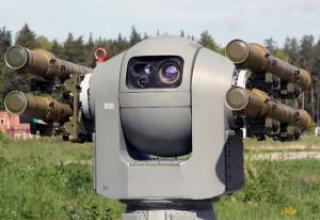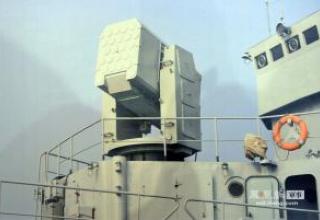The Umkhonto (Umkhonto - Spear) anti-aircraft missile system of various designs is used as a means of air defense of land objects and surface ships from massive strikes of cruise missiles, planes, helicopters and unmanned aerial vehicles during the day and night.
Umkhonto SAM systems are designed by South African company Denel Dynamics (formerly Kentron). The system development began in 1993. Testing of the ground-based system was completed in July 2005. The tests intercepted Skua supersonic targets with trajectories of different profiles, including on the counter course, low fly and evasive manoeuvres.
The ship version of the Umkhonto SAM system was developed as part of the Sitron project. The first successful tests were carried out on board the frigate Amatola (F145) of the South African Navy on 23 November 2005. Rockets with a telemetry head unit were launched from the Skua target near Cape Agulhas. All the launches were deemed successful, and the series of tests resulted in a real defeat of the target by a rocket with a conventional warhead. The tests were carried out under rather harsh conditions in the presence of unrest and confirmed the reliability of the complex and its interaction with the ship's systems. The successful firing conducted during the "Good Hope III" exercise in 2008 demonstrated the effectiveness of the complex against supersonic targets as well.
Umkhonto SAMs are currently in service with the South African and Finnish Navy. The Umkhonto complex is armed with 4 frigates of Valour type (MEKO A-200 SAN project) in the South African Navy, 4 patrol boats of Hamina type in Finland, 2 minefenders of Hameenmaa type, which received SAMs during the modernization process in 2006-2008. In early 2007, the Swedish Government concluded a contract to equip five of the country's Navy's Visby Corvettes with Umkhonto anti-aircraft missile systems. The cost of the contract for the supply of five systems is $150 million. However, in the summer of 2007 the missile purchase program was frozen.
In 2010 Denel Dynamics completed the development of an improved version of the Umkhonto-IR Mk2 anti-aircraft guided missile. The new SAM was demonstrated at the Africa Aerospace & Defence 2010 international exhibition in Cape Town. According to the developers, the Umkhonto-IR Mk2 is specially adapted for use in the Baltic Sea, has improved performance in a complex interference environment and is resistant to electronic countermeasures. In May 2010, the Umkhonto-IR Mk2 was designed for the Baltic Sea. The Finnish Navy reported the successful completion of the Umkhonto-IR Mk2 series of tests from the Uusimaa mine fence. Two targets, the Banshee UAV, were hit directly during the firing. The Hamina-type boats and Hameenmaa-type minefenders are planned to be re-equipped with upgraded missiles. Production of the Umkhonto-IR Mk1 has been discontinued. The South African Navy also reported that an order has been placed for a batch of Umkhonto-IR Mk2.
At present, the main efforts of Umkhonto rocket developers are focused on the implementation of the development program for the South African Armed Forces of a mobile ground-based launcher based on a 10-ton truck as part of the development of the second tier of a short-range ground-based air defense system (GBADS), known as the Protector project. In addition to Umkhonto air defense systems, the air defense system will include three-axis radars, Starstreak air defense systems and dual 35 mm anti-aircraft guns. The new system is intended to replace the Cactus (a variant of Thomson CSF Crotale air defense systems), which was adopted by the South African armed forces in 1971.
In order to ensure all-weather combat application of the system, the Umkhonto-R missile, equipped with an active radar homing head, continues to be used. In this regard, Denel Dynamics representatives stated that the company is looking for partners to finance, develop and jointly produce new versions of Umkhonto SAMs. Brazil was mentioned as a possible candidate, with which Denel Dynamics already has experience of cooperation on the development program Darter air-to-air missile.
Composition:
The Umkhonto rocket (see photo) is made according to the normal aerodynamic scheme and is equipped with a trapezoidal cross-shaped wing located in the middle part of the hull. The tail part has aerodynamic rudders, engine thrust vector control system unit (TPMS) and data line receiver. SHUT together with the aerodynamic rudders ensure the missile's inclination after launch towards the target and maneuvering with an overload of up to 40g. The marching solid propellant rocket engine is equipped with a charge of low-smoke mixed fuel and provides the maximum flight speed of the missile M=2. The combat unit is a shrapnel and blast weight of 23 kg, the fuse - non-contact radar.
The missile is controlled by a combined control system: a command-inertial system at the initial section of the trajectory and a homing system at the final section. Depending on the version, the Umkhonto missile can be equipped with an active radar (Umkhonto-R) or infrared CNS (Umkhonto-IR). The infrared dual-band homing head is similar to that of the Darter missile. The Umkhonto-R Surface-to-Air Missile (designated AWSAM - All Weather Surface-to-Air Missile) is equipped with an active impulse Doppler CNS, the Umkhonto-R has a range of 20 km.
It was reported that an upgraded version of the rocket, equipped with a launch accelerator, with an increased range of fire (Umkhonto-IR - 22 km, Umkhonto-R - 30 km). The launch weight of the new model is 190 kg, length with the accelerator - 4300 mm.
The missile is launched vertically with subsequent inclination towards the target by means of the SuvT. The Umkhonto LV is used in the target acquisition mode of the CNS after launch. Before the homing head captures the target, the missile is controlled by an inertial control system to the primary target designation data transmitted to the missile. The data transmission line is used to transmit correction commands in the middle section of the trajectory before the target is captured by the homing head, which improves the effectiveness of the SAM system for actively maneuvering targets and in a complex interference environment.
According to the developer, due to its vertical launch system, effective homing system and high firing rate, Umkhonto SAM system allows to effectively counteract saturation of the object's air defense system during massive attacks of enemy's air attack means. The missiles are launched directly from sealed transport and launch containers (TLCs), which serve for their transportation and storage. The missile leaves the TLC due to the thrust of its own engine, the exhaust gases of which are discharged up the circular gap between the missile body and the TLC. After the launch, the used container is removed and replaced by a new one. The launcher is recharged either at the base or directly at sea using an auxiliary vessel, taking into account the limitations on the turbulence.
The ship's SAM system consists of modules of the launcher with missiles in the PIC, a fire control system, launch sequence controllers (one for each 4 missiles), an antenna post and a transmitter of the remote control system, as well as a cooling system for the infrared SOS sensor before launch. The fire control system allows firing at up to 8 targets simultaneously. High reliability of the system is achieved due to the built-in self-test equipment, which provides minimal labor costs for maintenance personnel. In the forward part of the frigates type Valour (project MEKO A-200 SAN) of the South African Navy (see photo) are installed 2 modules of 8 missiles each (16 missiles in total) with the possibility of increasing to 32 missiles. Finnish boats of Hamina type (see photo) have one module for 8 cells located in the middle part of the superstructure, minefence of Hameenmaa type - 8 cells in the aft part of the superstructure.
Opto-electronic devices, ship-wide detection systems (for the sea version) or Thales three-axis radars (for the land version) can be used to detect air targets and provide target designation.
Ground-based Umkhonto model air defense systems consist of launchers, a command post and detection radars. The launchers of the complex are equipped with a package of six missile-powered industrial complexes and can be placed on various cross-country vehicle chassis (see photo). The boosters are equipped with a hydraulic system for lifting the package to the combat position, communication and navigation systems. The vehicles of the complex can be airlifted by helicopter.
Characteristics:
| Maximum firing range, km | 12 |
| Maximum target height, m | 10 |
| Maximum available overload | 40g |
| Maximum speed | 2М |
| Interception time at a distance of 9 km, s | 16 |
| Dimensions, mm: - length - diameter - wingspan |
3320 180 500 |
| Starter weight, kg | 125 |
| Weight of combat unit, kg | 23 |
| The dimensions of the container, mm: - length - diameter |
3800 650 |
Testing:
As of 01.01.1950, the factory batch of 230 shells was completed and sent to the Pavlograd test site.
In November 1949, pre-factory tests of 34 shells were carried out together with the fuse B-377 during which cases of missiles were revealed.
Special tests carried out to determine the causes of deficits showed that the most probable cause was an increased release of unburned reactive charge particles at the end of the active section of the trajectory.
In order to eliminate this phenomenon, in December 1949 a bench-top refinement of the engine was started with regard to aperture enhancement and ensuring that the powder charge was fixed in the chamber. After the end of the bench work and experimental firing for checking the reinforced aperture, the factory batch of projectiles was to be equipped with modified apertures on site and presented for factory tests in February 1950.
